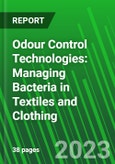Performance Textile and Apparel Manufacturers Turn to Plant-Based Anti-Odour Materials in Response to Concerns About the Adverse Effects of Conventional Technologies
Odour control technologies are key in preventing the development of odours and maintaining freshness in textiles and clothing. They function by helping to manage the presence of microorganisms on the surfaces of substrates to which they are applied. Odour control technologies were originally developed for sportswear and active apparel end uses. However, they have also become popular in other applications, including home textiles, health care, technical textiles and workwear, because of the benefits they offer. The increasing popularity of odour control technologies also stems from growing consumer awareness of the value of personal care and healthy lifestyles, and a growing understanding of the benefits of odour control.
The market for odour control textiles is forecast to expand in the ten-year period between 2022 and 2032, and manufacturers of odour control technologies who are likely to make significant gains will be those who are able to develop products that provide high levels of performance and, at the same time, address concerns relating to existing odour control technologies. In particular, certain lobby groups have raised concerns about the potentially detrimental effect on the environment and human health of existing odour control technologies that employ antimicrobial agents and nanomaterials. In response to these concerns, some manufacturers have turned to plant-based materials as alternatives to existing ingredients.
On another note, some manufacturers have focused on improving the durability of their odour control technologies in a bid to stake a lasting claim on the market for anti-odour textiles and clothing. In particular, the development of odour control technologies which can withstand more than 50 domestic wash cycles without affecting the natural bacterial flora of the skin would represent a significant advancement.
Who should buy this report?
- Manufacturers of fibres, textiles, clothing and chemicals
- Textile and clothing machinery manufacturers - spinning, weaving, knitting, sewing and import/export
- Textile and clothing brands and retailers like Adidas, H&M etc.
- Educational institutions like universities, fashion schools etc.
- Business consultancy firms
- Textile and clothing trade associations
- Government trade bodies
Table of Contents
SUMMARYINTRODUCTIONMARKET FOR ODOUR CONTROL TEXTILES AND CLOTHING
Executive Summary
Odour control technologies have emerged as a key solution for preventing the development of unpleasant smells and maintaining freshness in textiles and clothing. However, there are growing concerns about the adverse effects of odour control technologies on the environment and human health and these are posing a threat to the future prospects of the anti-odour textiles and clothing market, according to “Odour control technologies: managing bacteria in textiles and clothing”.
Odour control technologies were originally developed for use in the manufacture of sportswear and active apparel. However, because of their effectiveness in managing the presence of microorganisms in textiles and clothing, they have gained prominence in several other applications - notably home textiles, medical textiles, technical textiles and workwear.
The prominence of odour control technologies can also be attributed to growing consumer awareness of the value of personal care and healthy lifestyles. This is especially true given the benefits which odour control technologies offer, such as enhanced hygiene, prolonged freshness, and improved wearer comfort.
But in order to capitalise on the popularity of odour control technologies, manufacturers must invest in the development of new products which deliver high levels of performance and durability and, at the same time, address concerns raised by lobby groups about the detrimental effects of existing odour control technologies on the environment and on human health - especially those technologies which employ antimicrobial agents and nanomaterials. This is partly because fabrics treated with antimicrobial agents have been found to biodegrade more slowly than untreated fabrics. It is also because nanoparticles that possess anti-odour properties, such as nanosilver, have been found to wash off treated products during laundering. The nanoparticles released in this way may then find their way into waterways where they may damage the environment and cause harm to aquatic life.
In response to these concerns, some manufacturers are exploring plant-based materials as alternatives. Peppermint oil, for example, has been shown to be effective against odour-causing bacteria and strains of bacteria which can develop tolerance to antibiotics. Textile and apparel manufacturers who can accelerate efforts to develop odour control technologies made using plant-based materials look set to make significant gains in the years ahead.
Companies Mentioned
- Aqdot
- Devan Chemicals
- HeiQ
- Microban International
- Noble Biomaterials
- Polygiene
- Sanitized
- Sciessent
- The Lycra Company








